Do you listen to and trust your imagination? Become an improviser with your writing and learn to do so. Say yes to your story idea and don't block your creativity.
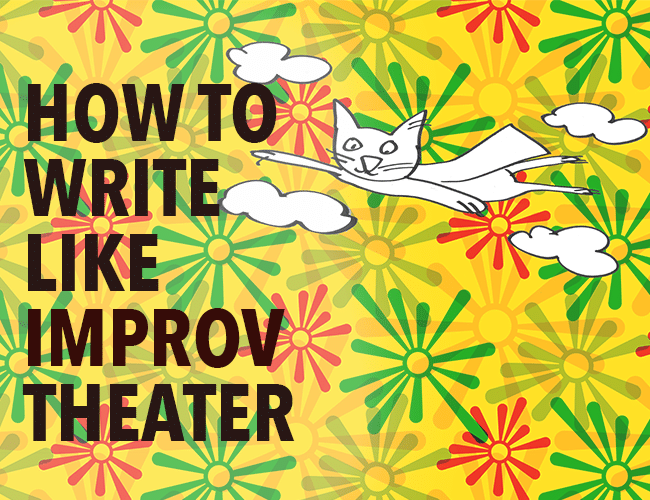
Patricia Ryan Madson's book Improv Wisdom shows us how to apply the concepts of improvisational theater to deal with real-life challenges. Today, I will look at how the concepts of improv can also apply to how we approach our writing.
Say Yes
To improvise means to create and perform (music, drama, or verse) spontaneously or without preparation; and to produce or make (something) from whatever is available.
The spirit of improvising is “yes, and.” In theater, an actor gets an idea to start the skit, or a member of the audience shouts out a word. Yes accepts the story idea. And yes, and continues it.
If the audience shouts out the words “cat” and “flying,” the actor will start acting with the concept of a flying cat. The actor might duck down while screaming, “Look out! There is a flying cat.”
Another actor on stage adds to the scene. The “And” could be the other actor yelling back, “Don't worry. I will knock it down with my badminton racket.” This adds something new to the scene and keeps the story going.
When I was in college I attended an improv show. They invited the audience to come up and do a spontaneous improv stand-up routine.
The first two people who volunteered were taken off the stage by a huge hook. They were taken off the stage after a few minutes as they told old jokes; they didn't say anything original. They didn't say “Yes” to an original thought. They relied on old stale cucumber jokes.
I also went on stage and did a stand-up routine. My first thought was to talk about my new toothpaste and my bird, and how I answered the door with white powder all over my mouth and bird poop on my shirt. I didn't get pulled off the stage by a hook.
The key word for improvising is acceptance. The other actor accepts the first part of the story and continues the story.
As a writer, accept your idea and continue the story, your story. Even if it doesn't make sense. Learn to trust your brain, your instincts.
Go with the absurd and write what you don't expect.
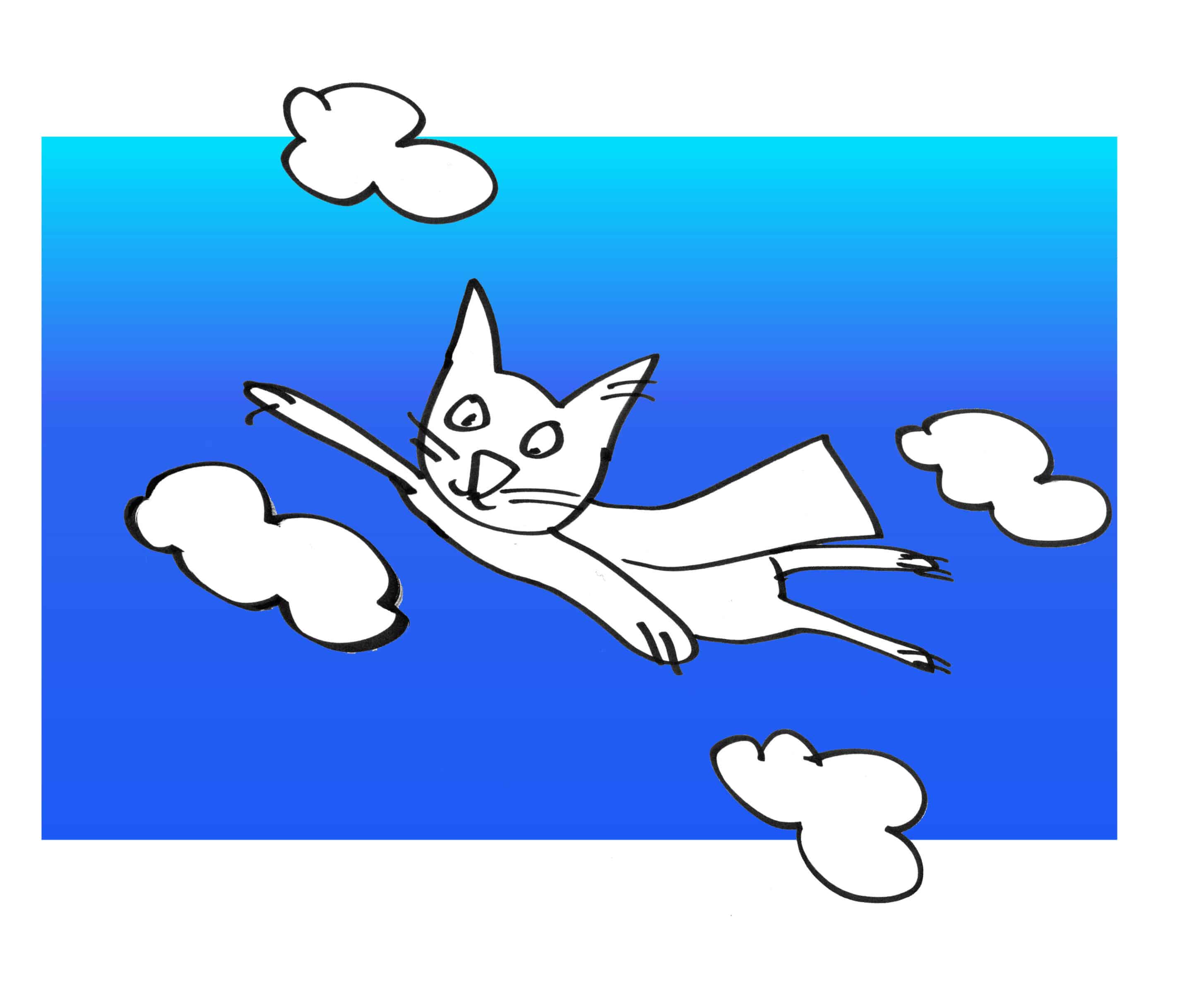
Don't Block The Story Idea
Improvisation fails when the actors don't carry the story forward. Actors want to avoid the cardinal sin of improv: blocking an idea.
As a writer, it is important to accept the ideas you come up with and carry the story forward. Blocking your own ideas would get you the hook if you were on stage.
According to Madson, blocking is a cardinal sin of improvising. She says:
Blocking is a way to try to control the situation instead of accepting it.
Do you remember the example of the cat and the badminton racket? Blocking would have happened if the actor had said, “No. It is not a cat. It is a dog, and it is not flying. It is running.”
When I was writing the actors' lines about the flying cat, my first idea was the badminton racket. My rational brain said to me, “You can't write that. A badminton racket? Find a better idea. And a flying cat? Don't say yes. Say no. Have a flying dog.”
I tried to stop the story. I was not writing as improv.
Instead, saying yes to a writing idea will allow other ideas to come, and the story will progress, grow, and develop.
To write improvisationally is to accept the first idea and build on it.
I showed the first draft of this story to Alice, my editor at The Write Practice. She said to me, “Yes, and” and gave me ideas to help develop the concept of writing as improv.
She could have said, “No, write about how to start a paragraph.” Or she could have said, “No, write about grammar rules.”
Writing as improv means writing spontaneously and working with whatever is available.
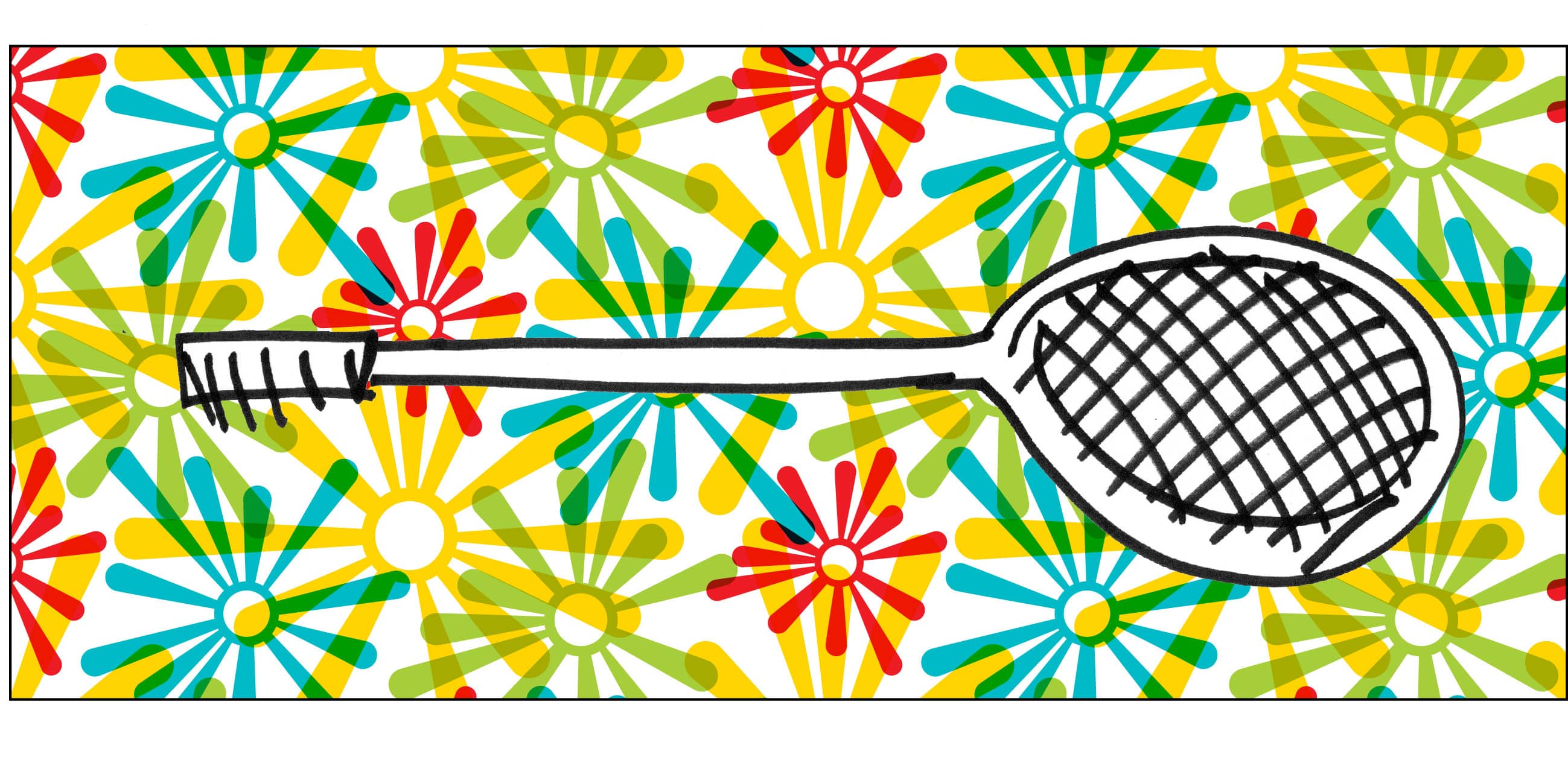
Why You Should Say Yes
Improvising your writing can help you when you don't have a clue what to write and when you know exactly what is going to happen.
Improvising is a skill to develop to learn how to trust your instincts. Think of your brain and how you think as the deep ruts in the ground where the wagon trains traveled. In some places in the prairies, you can still see the lines in the ground where hundreds of wagons traveled.
Your brain when it is writing often travels in the same paths as the wagon trains.
Working with the first idea that pops into your head will help you to learn to trust your instincts instead. You don't have to keep it in your story; you can edit it out later, or come up with more ideas.
When I took an introductory art class at the University of Saskatchewan in 1978, the professor told me to draw with my non-dominant hand. The drawings I made with my right hand and my left hand were totally different. The drawings with my dominant hand were stylized and stiff. My drawings made with my right hand were like the ruts left by the wagon trains.
When I switched and drew with my non-dominant hand the lines were more creative and expressive. Writing as improv allows your mind to go off the wagon trail and find new ways to write.
How to Improv Your Story
Start with a black screen and start writing the first story idea you get, and then keep going. Don't edit in your head; don't block your creativity. Where will your story go if you let it develop naturally? Will you have a badminton racket in your story? A flying cat?
“The key to great story, as with great improv, is to take the ideas that are there and build upon them rather than turning around and saying they won't work,” says Alice.
If you prefer to plot your story before you write, use the same approach to your plot outline. Allow your creativity to flourish and see where your story leads you. (Notice I said where your story leads you, not where you lead your story.)
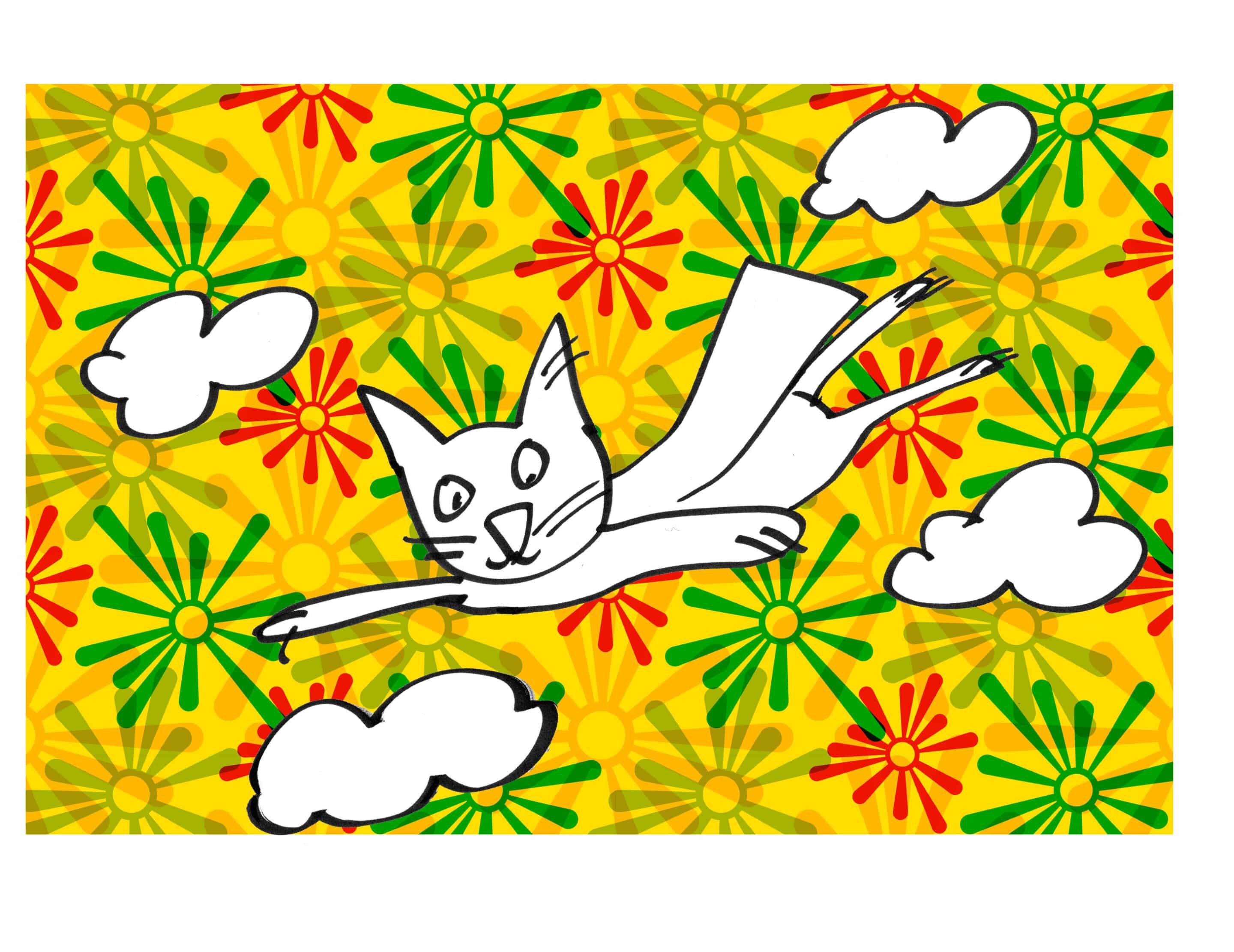
Start Anywhere
Madson encourages you not to hesitate, and to begin with what you have, as though the idea selected you rather than you selected it.
Start your story with your first thought. Begin immediately with your first idea. Start writing and trust yourself.
The improviser focuses on making the first idea into a good one, rather than searching for a “good idea.”
A writer can miss a good story idea and stall with their writing because they are waiting to find the perfect starting place or the perfect idea. Our first thoughts for a story might be ignored. Don't let that happen—go with your first idea and see where it takes you.
Whatever you do, please don't discard your first ideas because you think they aren't good enough.
Start writing with your first idea, and learn to trust your instincts, work with what you have, and start where you are.
Have you ever tried to write using improv? Or have you ever tried improvisational acting? Let me know in the comments.
PRACTICE
Writing Improv Game
Today we are going to write a story together using improv techniques. We will write stories together, as though we are telling a story on stage.
Let's write stories using “Yes, and.”
Each person can start their own story, and other commenters will add to it, like improv actors on a stage. The first person who started the story will decide when the story is over by writing the last sentence and THE END.
Write one sentence as a comment on this post to start your story. Then another person will write one sentence. And another commenter will add another sentence. And another commenter will add another sentence to keep the story going.
Say yes to the first idea, and then add to it.
Please take fifteen minutes to start a story with one sentence, and also add to someone else's story.
Let's learn together how to accept an idea and add to it.
xo
Pamela


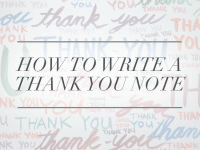
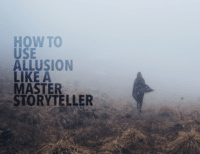



“First thought, best thought.” This was the phrase that poet Allen
Ginsberg used to describe spontaneous and fearless writing, a way of
telling the truth that arises from naked and authentic experience.
That was Karen’s thought as she considered a subject for the High School Science Fair.
Karen was sick and tired of coming in second place. She had to beat Cindy this year. She had to.
“What if I could find out what Cindy’s project is?” she thought.
Karen thought about hacking into Cindy’s computer, but decided instead to go with the low-tech, time-proven technique of peering over her shoulder at her lab notebook during Honors Biology class one Tuesday afternoon.
When Cindy got up to sharpen her pencil, Karen took advantage of the opportunity. Instead of notes, she saw the name Bill written in curly handwriting with hearts drawn all around it.
BILL!!??!!
Karen suppressed a giggle.
The only person in school named Bill was her brother. Her brother? Hearts? Cindy?
Karen caught a glimpse of Cindy returning to her desk.
Karen raced back to her desk but not before Cindy saw her looking at her notebook.
Cindy sat down calmly, then looked over her shoulder at Karen with an ominous glare.
She opened her mouth as if she was about to send a nasty comment Karen’s way, but was cut off as Mrs. Watterson started to speak.
“Today will be no ordinary day,” their wacky science teacher began, “No- today- we will be crossing the lines that routinely separate reality and imagination…”
She shooed her ominous warning away from her body with wiggling fingers, for added dramatic effect.
“For today, we will be talking about psychology!”
“Isn’t this biology class though?” Cindy asked.
“Well yes, but the board of directors had to cut the budgets, so the entire department of psychology has been moved to the Neurology branch of the science faculty.”
The princess screamed at the wretch in the mirror.
Yes, and it shouted back to her, “This is what you get when you lie.”
She slammed her fist into the mirror, the glass crackling and digging into the meat of her knuckles.
But what poured out of the cracks in her knuckles was not blood…
Blood, as we call it, is a red liquid, but what streamed out of her clenched fists, was not red, but bright, cloudless sky blue.
The same blue as her daughter’s eyes.
She rushed to the cradle where her daughter lay, and saw the eyes looking back at her were drained of colour.
Her eyes were turning black slowly
And the princess picked up a baseball bat, swung it hard, and shattered the mirror that displeased her…
“Knock, knock” there’s someone knocking on the chamber’s door.
There was just something about the knock sound that did not sound like her mahogany door.
My mom used to play a game called “Rigamarrol” with us. We’d share storytelling – everyone gets a chance to improvise the next plot point. Very fun and a great way to inspire creativity in children.
“Wow! Can we play the game your mom played?” I asked.
Sure, lets play the game, but first, lets make popcorn and watch Ed Sullivan.
“I LOVE Ed Sullivan,” I exclaimed. “Who are his guests tonight?”
But Ed Sullivan is on at the same time as Lawrence Welk! You PROMISED we could watch Lawrence Welk this week.
Quit your whining. The only night we watch Lawrence Welk is on New Years Eve. Now sit there and put the salt and butter on the popcorn.
The sound of thunder surprised him, and he dropped the gun.
As the gun clattered into the gutter, and he jumped after it, a voice in his head yelled at him to stop.
He ignored it, he was sick of the endless discussions and illusions, he grabbed the gun out of the water, and while the rain poured around him, a voice behind him whispered: “You failed. Again.”
But the voice in his head was very stubborn. ‘I will not stop until you give in,’ the voice inside whispered,’ You need to stop what you are doing?!’
“No. No I will not,” he gritted his teeth as his grip on the gun tightened. Even though he tried to deny it but the voice was starting to get into him
It was the voice of a stubborn six-year-old girl, one he knew very well.
The same stubborness that was well breed in his genes
“I’m your father,” he said, “don’t tell me what to do.”
The voice huffed in annoyance,” Well that is unfair,” the voice could be heard frowning.
“Life isn’t fair,” he said, pushing his way past the voice. “Get over it.”
She looked at him and said “My father is dead!”, then pulled out another gun and shot him. Her aim wasn’t so good – his kneecap exploded in a pink mist.
She closed her eyes and walked into the lake until the water was over her head.
Suddenly, something grabbed her and dragged her to the bottom of the lake.
Kicking her feet, she struggled to escape from the grasp that held her so tight, pulling her under. However, a part of her wanted to give in to the force and allow herself to drown. She looked down below, gasping, as she realized what was happening…
Her favorite pair of high-top Converse were been taken off by someone with webbed fingers.
To her surprise, the face accompanying the fingers was that of her brother who had drowned in that same lake ten years previously.
Her lungs gave up and was filled with water. Her brother wistfully added, “Give in, and it will hot hurt you.” He was right.
As her lungs filled water, she started to grow gills on the side of her neck, and her hands started to form webs between her fingers.
I can’t remember how I ended up eating angel cake in the Philippines, but I do remember that mangy cat, so I follow it.
Like a kid chasing bubbles in the park, I followed it, for that moment I stop thinking about consequences.
I was so distracted by the cat I dropped my cake in front of a monkey.
The monkey picked up the cake, chattered something that sounded like “Hamlet,” and ran away.
He climbed up a tree and began eating the cake, then he began gagging, keeled over and fell to the ground dead!
Surprisingly someone yelled, “Look! His chest is moving! I think he’s alive!”
The cake was apparently stuck in his throat. Except that it looked nothing like the dull yellow of the cake. It was sparkly white.
“Wait a minute!” someone yelled. “That looks like the grooms carnation!”
Is the wedding ring still tied to the carnation or did the monkey swallow it?
The light here isn’t too good, I can’t tell what’s in there. Maybe we can give him a Heimlich maneuver. Can you give a monkey a Heimliching?
Yes, quickly now. Lets save the monkey’s life! Heimlich the monkey! Heimlich the monkey!
A man wearing brown khaki clothing came running up and said “Ah, there he is! I heard you calling out his name, but how did you know his name was Heinrich?”
What word comes in your mind when you hear the word bipolar? Someone crazy? Moody? A smile cutting through the one’s heart? In m mind comes the word…..Me.
While eating in the kitchen my eyes drifted to the cabinet where my the pills, which were supposed to heal me, were kept
And on the counter was a large boa constrictor with my bottle of pills in its mouth.
It took a moment for me to react.
Warily, I whispered “Here sssssnaky ssssnaky…”, somehow thinking that it would obey me.
I thought perhaps i should get a flute and try to charm the snake.
However, as a new flautist who could only micmic the sounds of a dying cat. (well, me in real life) I second-guessed myself, thinking I would probably end up in greater danger. It’s just a pill. I shall skip today’s dosage and hope the snake will go away tomorrow.
However, as if reading my mind and bent on proving me wrong, it hadn’t.
So, the next day I came to the kitchen armed with a cage full of dead rodents, hoping to lure the boa out of the room.
If I thought it would work I was wrong. The boa just sat there with my pills. If I didn’t get the dosage of the day I would probably be a mess, which my mother would not like and I will have to hear a long lecture on the importance of the pills but she won’t believe that a boa was in my kitchen, she will perhaps call me delusion. I wasn’t was I?
But then again, I was a bipolar. So how could I be so sure that I am not hallucinating? The boa could very well be actually a thick pipe!
Grabbing a pair of scissors I cut out my bottle of pills from the boa. Then I took my pill and put the boa into a bag. Maybe my mother could make soup.
But just as I entered my bedroom I found myself face to face with another strange sight. The dead rodents were deep in conversation with the soft toys in my room.
The dead rodents were trying to find the box that would make them alive again.
The wind blew the front door open, and before anyone could come and shut it, I ran outside…
“Free at last!” I thought.
Then it hit me like a ton of bricks, I forgot to put on clean underwear!
I was still as dressed as Tarzan while I stood at the door, hoping there was no one in sight. My eyes chose to prove me wrong.
The little girl of the house across the street was staring at me with wide eyes. She shouted excitedly, “Uncle Jonny! Are you going on a fancy dress party? I wanna go too! “
I would love for you to come to the party. Let’s make chocolate chip cookies and bring them with us.
But there was one problem. There was no costume party to attend in reality
No reason to drop the idea of making chocolate chip cookies, though!
But wait a minute! Why did I came running outside like a madman? Uhhhh…. I remember now.
I wanted to see if I could catch a mouse and eat it.
But the idea of chocolate cookies seems more appetising now.
I walked back into the house, closed the door and made chocolate chip cookies.
Then I shared it with my little neighbor, who was jumping with excitement.
What shall I do? What shall I do? I wondered. I looked around and caught sight of laundry hanging on the line, so I jumped up, yanked off a kitchen towel and tied it around my waist.
With hands sweaty and her heart racing, she quickly sat down in front of her television set, closed her eyes, bowed her head, and prayed, “Thy Will be done.”
I think I have without knowing. And, I like this idea. Thank you.
“Chicken again?” Steve grumbled as he sat at the table for dinner.
The chicken sneered and said “Steve again?” giving him the feather.
Steve bowed his head, closed his eyes, and pretended to pray.
Steve loved animals until the talking chicken sat opposite him everyday and watched him eat. Like a mother the chicken would cluck at him until he finished his vegan meal the chicken set.
It was just another plate of corn and he was already sick of it. Yet, he had to spare a thought for his ears.
Millions of people eat chickens everyday around the world. So why him! Why does he suffer this incredulous fate alone!
He was so sick of eating corn he threw the plate across the room and stormed out the kitchen. He wasn’t going to have a chicken boss him around anymore.
But the chicken grabbed him from behind, using its wings as hand and attacked him with its sharp beak.
Steve, grabbed the chicken by the neck and twisted. He turned the oven on and threw the bird in.
Steve peered through the glass in the oven door and saw himself peering back.
Steve grabbed the oven door and quickly opened it. Out of the oven someone who looked just like Steve jumped out.
And he gave a triumphant huff, “I am free! “
(haha!)
She faithfully steps into the room and sits down in front of her television. With trembling hands and the pounding of her heart, she bows her head in prayer and says these four words; “Thy Will Be Done.”
And as her head is bowed the woman on the television screen climbs out of the television and sits beside her.
“Be done with what?” she asks.
The chocolate cake in the oven. I keep burning it. How will I get married if I can’t bake a cake.
Josh slicked back his hair, looked deeply into the mirror and said “Are you talkin to me – Are you talkin to ME?”.
He figured that the clone behind the glasswall was.
“Fine, hello” was what he said. No matter how he convinced the clone to talk to him, it wouldn’t. It would micmic his every action, though in the exact lateral opposite such that their gestures would meet if you were to look from behind Josh .
As Josh walked away from the mirror, the clone behind the glass wall stepped out of the mirror and started to follow him.
Ever since it has left the mirror, it has just turned into a back patch. Having been tormented by studying optics in physics, I know for sure it is not my shadow, neither was it my reflection in the mirror.
There was something different about the clone … or was something different about me?
Josh jumped into a lake and the back patch turned into a giant squid.
My book is all imagination, imagination and more.
It was called “My book” for a good reason.
It was my book because I hate to share. My brother kept taking my book and saying it was his.
Now that’s a good imagination … him thinking that he could write those magical words that swirl and paint and float off the page to pursue an adventure.
He tried to take my book to school. He wanted to tell the teacher it was his imagination. I painted my brother floating away out the window.
But injustice prevailed and the teacher believed my brother’s claim of ownership of my book.
I grabbed the book and slammed it over my brother’s head, then I ran out the door and jumped on a train to China.
The antique model of Lord Ganesh (A God with the head of elephant and body of man) had been in the showcase of my grandmother’s house for ages. I had never seen anything out of ordinary with it. But today I got a strange feeling that it was following me with its eyes throughout the evening.
Every time I took a bite out of my apple I thought someone was staring at me.
But no one was in the room. Then suddenly I discovered that the stone eyes of the idol were twinkling.
… ruby red, then flashing turquoise blue … My attention was interrupted by an “ahemmm:’ clearing of a throat.
I was shocked shocked that I fell face down from the sofa, the half eaten apple flying out of my hand, as I took into the scene in front of me.
Lord Ganesh was opening the showcase. His hand pushed open the glass door and he stepped out of the case and was walking towards me.
He extended his arms towards me and said in an intimidating voice, “Give me the apple.”
I glanced at the half eaten apple on the dusty floor.
He make an indignant sound and said, “Not that one, you idiot. I want the Apple.”
You want my computer?
“How long do you expect me to stick to this hundreds years old fashion! ”
“W-what? ” I stuttered.
“I want to do online shopping.”
Would you like to buy a coat? It’s cold in Minnesota, and you only have pants.
“That would be cool. But before that I need dollars to bye those and a bank account to pay those online!” he said thoughtfully
Here, have all of my money. I will share everything I have with you, even everything in my fridge, and all of my peanuts.
Sometimes memories are the worst forms of torture. The things that never leave us haunt us the most…. silence filled the crowd standing in a cold bilzard of fear.
Then the crown parted to make way for the largest elephant I had every seen. It was wearing a polka dot dress and was carrying a bag full of bananas.
A group of monkey musicans, wearing green jackets and black leggings were loping behind, strumming on their guitars and singing, “I went to the animal’s fair, The birds and the beasts were there…’
No wonder I was afraid.
The last time I saw an elephant it had killed my father. I wanted to run but I couldn’t move. The elephant came closer.
I love this game, Pam. I tried it verbally with my junior school students, but never online, this way.
I added to the story begun by Harper, and will check to see how it develops.
Thank you, Pam.
A hug for you and for all your cats,
From,
Minnie, DinDin, (new greay tabby of six months) and Lilian
Hello Lillian,
So nice to hear from you and the cats. Congratulations on DinDin coming to live with you and Minnie.
Wishing you all our best,
Pamela, Harper, Charlie, JR, Nepeta, Oscar and Clara.
An enormous, green frog jumped out of the pond, and instead of croaking, he began to whistle…
He had just finished reading Huckleberry Finn, and was ready for a down-the-river-on-a-raft adventure.
The frog took his copy of Huckleberry Finn back to the library and took out another book to read while he went down the river on a raft.
Choosing the book, Entomology for Dummies, the frog commenced to identify a suitable meal.
The frog had only been fed hamburgers and ice-cream at the lab he had escaped from. He didn’t know what insects would be good for a frog.
At breakfast this morning, the French Toast tasted as if it was from Germany
When he looked out the window he saw that he was in Germany. He said, “But, but, but, I live in France.”
Suddenly the french toast flavour in his mouth was muddied somehow by a clouded memory of a late night train journey. Just glimpses at first, but then he could hear the clack clack clack of the tracks…
Everything’s like a coin when you look at it close enough, with both the good side and the bad side. Some people, however, just refuses to flip it over to see the other side for no reason.
Then from the back of the theater a large man rushed the stage and grabbed the coin out of her hand.
She sat in the woods with her empty carton of milk, staring up at the sky.
She jumped up just in time as a large milking cow was falling out of the cloud right over where she was sitting!
Moooooo! – Splat!
Almost a pint of milk spewed from her nose at the unexpected sound and the blast from the shock wave. “Awesome!”, was all she could muster up on such short notice.
The cow stood up dazed and asked where the closest Walmart was.
“Well, there’s a Target half mile from here.” She turned her head away to wipe the milky snot from her upper lip.